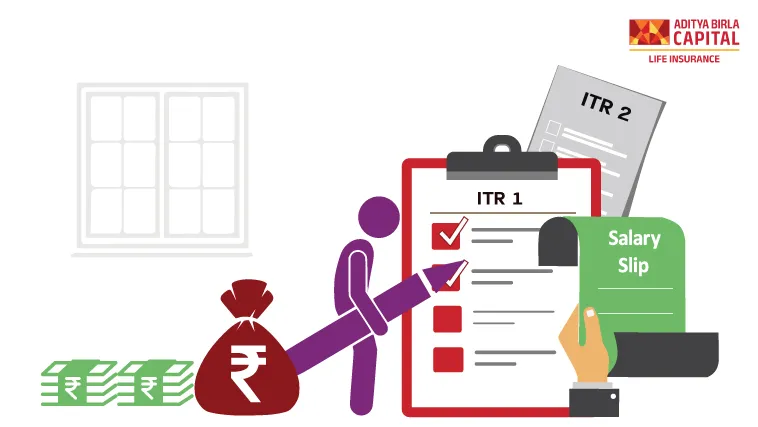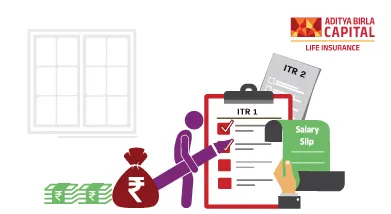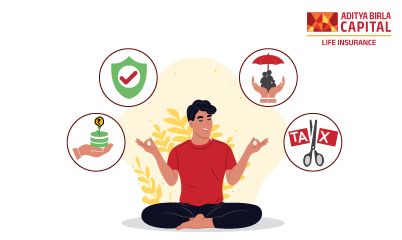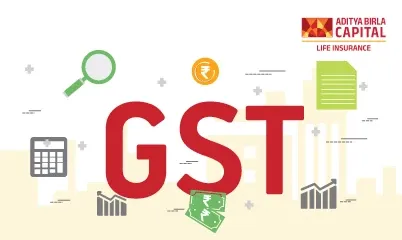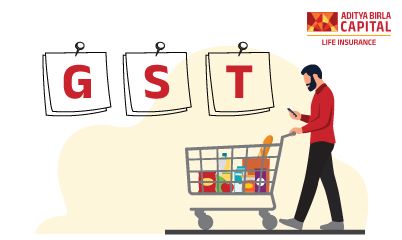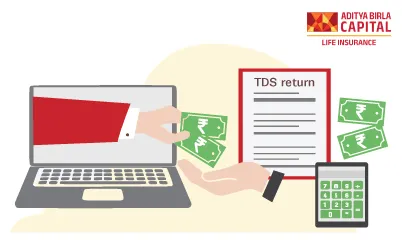Every person has a vital obligation to file their income tax return. In addition to being required by law, it is also every citizen's responsibility to pay taxes on time and honestly. The development of the nation is closely correlated with these taxes. After all, the taxpayers' money makes the government run smoothly.
However, a sizable portion of the populace still does not understand how to submit their taxes. Read on if you have trouble figuring out how to submit wage information for ITRs 1 and 2.
Most of them are either unsure of the category of the IT Return they fit under or are uncertain of the process. Many individuals see the job of filing taxes as tiresome and challenging. However, submitting the IT return is not difficult. This post will explain how to enter wage information in ITR 1 and ITR 2.
You should know the paperwork that must be completed when completing your IT Returns. The forms you must take entirely depend on your income, yearly income, and the exemptions you are qualified for.
Before you file your taxes, please educate yourself on them so that you can complete the process correctly, saving you time and work and offering you peace of mind. Let's first determine which of the two forms you must fill out before learning how to submit income information for the ITR 1 and ITR 2 forms.
Income Tax Return-1
If you are or have any of the following, you must complete the ITR 1 form:
- Paying employee
- Obtain a pension
- Income from one residential property
- Earning money that isn't taxed
- Income from other sources (excluding Winning from Lottery and Income from Race Horses)
If you are or have any of the following, you cannot complete ITR 1:
- Producing money via a company or profession or becoming an entrepreneur
- Income from many properties
- Earning money via endeavours such as gambling, the lottery, etc.
- Income from taxable capital gains
- Own a taxable agricultural income of more than INR 5,000
- Over Rs 50 lakhs in total revenue ""this"".
Income Tax Return-2
If you are or have any of the following, you must complete the ITR-2 form:
- Paying employee
- Pensioner
- Revenue from several residential properties
- Earning more than INR 5,000 in tax-free agricultural income
- Earning money by games of chance, gambling, etc.
- Income from capital gains
If you are or have any of the following, you cannot complete the ITR-2 form:
- An entrepreneur or HUF who derives their income through a job or a company
- Are admissible on Form ITR-1
ITR1 and ITR2 Filing Documents Required
The last day to submit your income tax return is July 31 of each fiscal year. Being aware of the decrease aids in better planning and preparation. You have time to collect the necessary paperwork; filing may be completed quickly and without difficulty, if you do it on time.
Payroll Personnel
If you were a paid employee, you would need
- I.D. Card
- The employer delivered Form 16
Interest-related Income Documents
- Your passbook or bank statement that details the interest you earned on your savings account
- A statement detailing the interest you have earned on fixed deposits
- Bank TDS Certificate issued
Form 26AS
The Income Tax Department offers Form 26AS, which may be obtained from the IT Department's main website. This is an overview of your income tax over a fiscal year. It displays the various taxes deducted from your income.
Documents about Section 80 investments
Investment records are eligible for Section 80 deductions, such as PPF, ELSS, LIC premium certificates, etc. Several of the paperwork is needed to claim deductions. The following papers need to be accessible:
- Giving to the Provident Fund
- Children who have paid their tuition
- A contribution to life insurance
- Stamp duties and registration fees
- Payment for a mortgage
Various Documents
- The interest on the mortgage loan is paid.
- Interest paid on a student loan
- Stock transactions made throughout the fiscal year may be subject to capital gains tax.
Who Has To Submit Income Tax Returns?
Anyone whose income is above the following basic exemption level is required by law to submit a return.
Additionally, the following individuals are required to make a return.
-
Those with deposits in their current accounts of at least Rs. 1 crore.
-
For whoever wants to make a tax refund claim.
-
Regardless of income or loss, a person who wishes to carry forward or set off losses should submit a return.
-
Someone who must provide returns as evidence of income for loans, etc.
-
Individuals who get income from overseas assets.
Several Recent Changes
-
If their sole sources of income are pension and interest income, residents over 75 are excluded from submitting tax returns.
-
The Income Tax Department has also unveiled a new e-filing system that is easier to use and provides instructions at each stage. A straightforward Q&A method or pop-up explanations are available if you have questions about critical areas.
-
The return form can use the option under Section 115BAC (New Tax Regime), although this option is only valid up to the deadline specified in Section 139(1)-Original Return.
Comparing ITR-1 and ITR-2
Completing and submitting the proper forms, such as ITR-1, ITR-2A, and ITR-2, when completing income tax returns is crucial. This is done based on the kind of income, exemptions from pay, etc. Time and effort may be saved by submitting returns in the proper format. Depending on the type of income one makes and how that income is made, one must complete a different Income Tax Return form (as an individual, HUF, Business, etc.).
Follow this straightforward technique to choose which state you must complete for your income tax returns instead of being discouraged by the abundance of forms and repetitively meaningless information.
Let's first define the terms often used in the forms so you can make an educated choice before learning which state you need to use:
1. Income from Salary:
This only occurs when there is an employment connection, and you get financial compensation for providing your services to the employer or business. The term "gross salary" refers to the total income after deductions. Pension income is taxed in the same manner as salary income.
2. Income from Household Assets:
Whether or not you get rental income from any residential or commercial property held in your name, you are still subject to taxation. The value of the property's earning potential will be taxed. There are several exclusions from this tax's overall amount (ex., Home Loan).
3. Profits and Gains of Commercial or Profession:
This refers to money earned via the sale of goods or the provision of services by a business entity or through the provision of professional services to clients. The amount that remains after removing all incurred costs (including asset depreciation) from the income received is the amount that is subject to income tax. Taxes are levied on profits.
4. Income from Capital Gains:
Any earnings resulting from the transfer (sale) of capital assets that have been held as investments (such as gold, land, property, equity, etc.) are subject to taxation under this area. Depending on how long they were held before being sold and whether short-term or long-term, various tax rates apply to the capital gains (profit).
5. Money from Other Sources:
All income derived from sources other than the four listed above is included under this area. Under this area, taxes are owed on payments, including interest on deposits, profits from lotteries and game shows, gifts (from people other than family), and others.
The many forms that must be filled out depending on factors like:
1. Who has earned income:
Individuals, HUFs, businesses, and firms may make money.
2. Residential Status:
There are differing tax ramifications for resident Indians and NRIs.
3. Income Type:
To determine the income category under which you have earned money, see the five items above.
4. Forward Carrying of Losses:
Losses carried forward (such as a loss on the sale of a capital asset, etc.) result in a reduction in future tax obligations.
Guidelines for Including Salary Information in ITR1 and ITR2
-
The taxpayer must provide a full breakdown of their salary and any income from real estate holdings to submit the ITR 1.
-
The ITR must be submitted by August 31. After that, if the ITR is filed before December 31, 2022, a late charge of INR 5,000 must be paid. You may submit your ITR after this by paying a fee of 10,000 Indian rupees. Remember that the fiscal year runs from April 1 to March 31.
-
The total wage would not be entirely taxable; instead, certain portions would be wholly exempt from tax, and others may be partially exempt. You must carefully store and preserve close to hand all of your investment and salary-related paperwork.
-
If you have changed jobs, you must have Form 16 and wage statements from your previous employer. It would help if you combine your total earnings of all prior employment.
-
Toto understands what information must be submitted and which documents must be attached; download Form 26AS and carefully read through it. If you do this, you'll spend less time and effort submitting the ITR.
-
Some deductions from the GSI, or gross salary income, are permitted under Section 16. Both the Entertainment Allowance and the Tax on Employment may be claimed.
-
You must state the amount payable if you own a dwelling property.
-
According to the Supreme Court's rules, it is necessary for everyone who is submitting their ITR online to include their Aadhar. Your 12-digit Aadhar Card number or 28-digit Aadhar enrolment number must be mentioned.
-
The CBDT (Central Board of Direct Taxes) made specific changes to the Forms to make filling out ITRs easier. There used to be nine forms, but there are now just seven. The ITRs 2, 2A and 3 have been simplified. Now Form ITR 2 alone has been introduced instead of them.
-
Keep in mind to provide all your bank account information, including the IFSC code and bank account number.
-
If you have deposited INR 2 lakh or more in an account, you must include the source of the cash while filing your ITR and the bank account information, including the name, IFSC code, and account number of the bank.
How to Complete Schedule S of the ITR2 Income Tax Return
-
Compensation:
When filling out Form 16's Schedule S of Gross Salary, you must leave out any exempt and non-exempt allowances, perks, and profits earned instead of salary.
-
Allowances:
A sum of all the benefits covered by Section 10's exemptions, such as the HRA (house rent allowance) and TA (transport allowance).
-
Value of Perquisites:
Form 16 must include the Value of Perquisites under section 17(2), which is 21600.00 (as per Form No. 12BA).
-
Profits:
Form 16 must include any profits earned instead of wages under Section 17(3) 0.00 (as per Form No. 12BA).
ITR-2 Schedule S Filling Advice
Guidelines for Completing Schedule S in ITR-2 After HRA Claim
If you are salaried, you must have your Form 16 handy to use as a guide while entering your payment information. Additionally, you need to confirm whether or not a professional tax is included in the compensation you get. Most professions have a fixed payment of INR 2,400 to 2,500 per year.
Advice on How to Complete Schedule S in ITR-2 If HRA Has Not Been Claim
If your HRA is not specified even though you are qualified, you must calculate it using the method provided in Form 10's Section 10 if this is the case. Preferably, the HRA should be claimed from the item that costs the least.
- The amount of actual HRA received
- 40% for non-metropolitan cities and 50% for metro areas of, the Basic Salary
- 10% of the salary is subtracted from rent paid.
For instance, the HRA is INR 1 lakh if your LTA is INR 50,000. According to the Income Tax Act, a 1.5 lakh rupee allowance is exempt.
Conclusion
This was the ITR-1 and ITR-2 form discussion for AY 2021–2022. You will undoubtedly find the explanation above helpful when you choose the appropriate form and complete its fields.
The information about Form-16 and TDS deductions is pre-filled to the degree it is accessible on the TRACES website. The remaining information should be typed into the return form piecemeal. The return must also, ideally, be confirmed by an EVC or an Aadhaar OTP.

